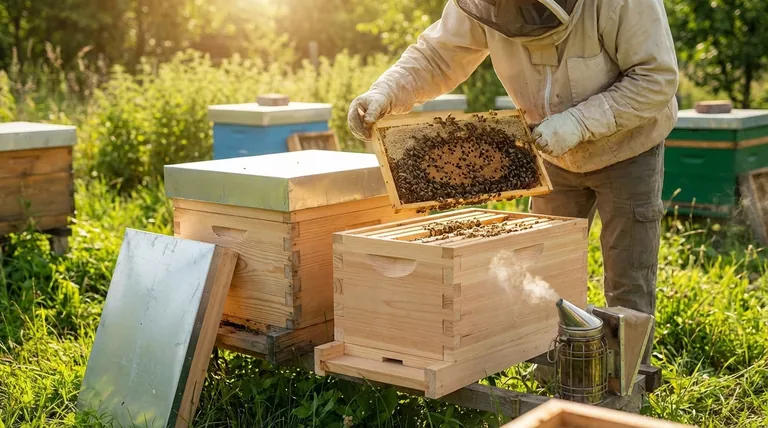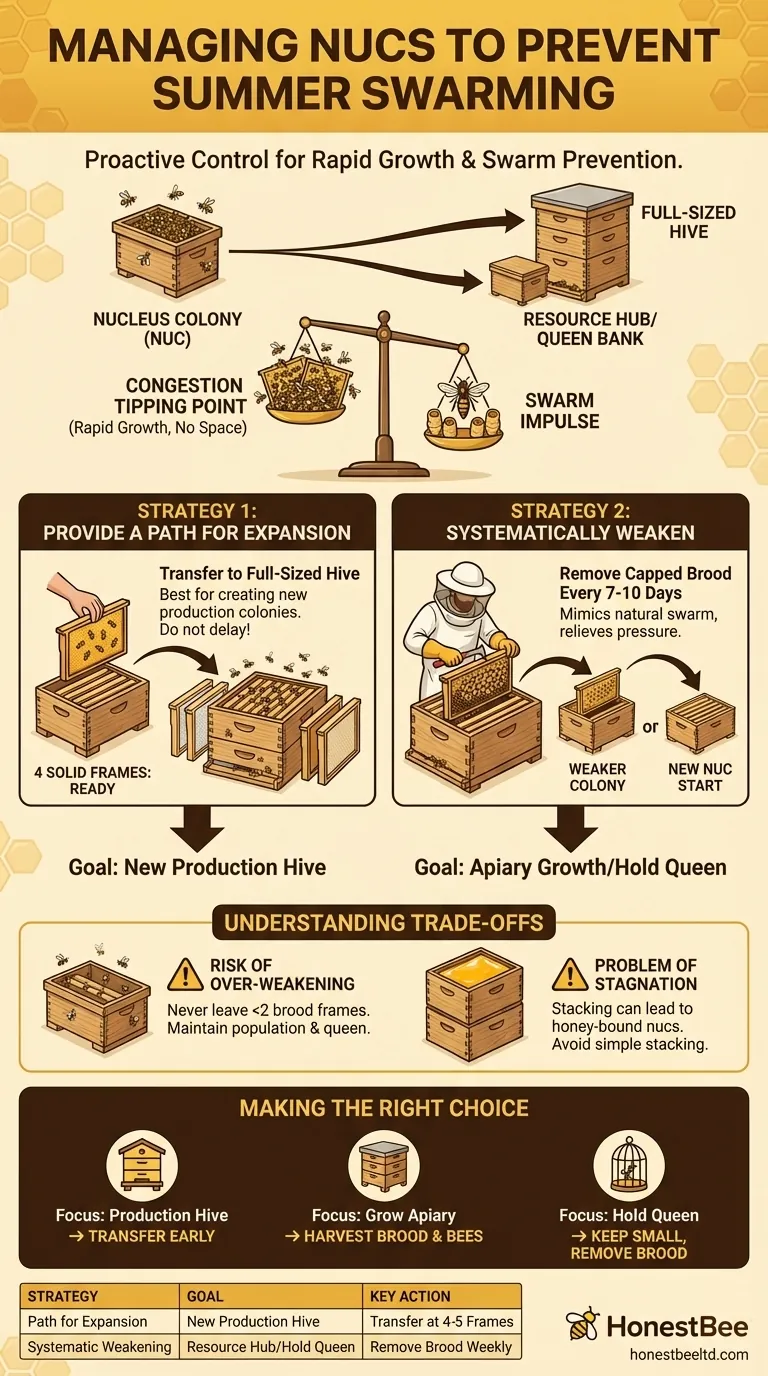Managing nucs to prevent summer swarming is an exercise in proactive control. Because nucleus colonies are designed for rapid growth, they can quickly become congested and trigger their natural swarm impulse. The core prevention strategy involves two opposite but complementary actions: giving the colony a path to expand or systematically weakening it to relieve population pressure.
A nucleus colony's primary drive is to expand. Summer management isn't about stopping this growth but rather channeling it productively. You must either provide a path for expansion into a full-sized hive or systematically harvest its growth to prevent the colony from swarming out of its confined space.

Understanding the Swarm Impulse in a Nuc
A nuc is, by its nature, an unstable state. Its small size and strong queen encourage explosive population growth, which is the primary driver of the swarm impulse.
The Congestion Tipping Point
Swarming is a direct result of congestion. When the bees feel they are running out of space for brood, nectar, and pollen, they begin preparations to divide the colony.
In a nuc, this tipping point arrives quickly. Watch for frames that are completely covered in bees, a brood nest with no empty cells for the queen to lay in (known as being "honey bound" or "pollen bound"), and the first signs of queen cells.
Why Nucs Are Prone to Swarming
A nuc's purpose is to grow. The combination of a young, prolific queen and a dense population of nurse bees creates a powerful brood-rearing engine. Without an outlet for this growth, the colony's natural programming will initiate swarming.
The Two Core Management Strategies
Your management choice depends on your overall goal for the nuc. You can either allow it to achieve its full potential or use it as a resource hub for your apiary.
Strategy 1: Provide a Path for Expansion
This is the most straightforward approach if your goal is a new production colony. You relieve pressure by giving the bees more room.
The moment a five-frame nuc has four solid frames of bees and brood, it is ready to be transferred into a full-sized 8-frame or 10-frame hive body. Delaying this transfer is the most common cause of nucs swarming.
When transferring, place the nuc frames together in the center of the new hive body and add new frames to either side. This keeps the brood nest intact while providing ample space for the queen to expand her laying.
Strategy 2: Systematically Weaken the Colony
If you want to keep the colony in a nuc box—perhaps to hold a spare queen or for slower expansion—you must actively weaken it. This mimics the natural process of a swarm, but in a controlled manner.
The most effective method is to use the strong nuc as a brood source. By removing a frame of capped brood every 7-10 days, you reduce the number of emerging bees and relieve congestion.
This "harvested" frame of brood can then be used to boost a weaker colony or to help start an entirely new nuc, effectively turning your strong nuc into a resource factory for your beeyard. You can also simply shake the adult bees from a frame into another hive to reduce the population.
Understanding the Trade-offs
Neither strategy is without its considerations. Effective management requires understanding the potential downsides of your actions.
The Risk of Over-Weakening
When using a nuc as a brood source, be careful not to remove resources too aggressively. Taking too much open brood or too many nurse bees can set the colony back significantly.
A good rule of thumb is to never leave the nuc with fewer than two solid frames of brood. This ensures the colony remains queen-right and has enough population to defend itself and continue foraging.
The Problem of Stagnation
Simply giving a nuc a second story (stacking another nuc box on top) without a clear plan is often a poor solution. It can create a tall, unstable hive that is difficult to inspect.
Worse, the bees may simply fill the top box with honey, congesting the bottom box and swarming anyway. Direct expansion into a full-sized hive is almost always a better path.
Making the Right Choice for Your Goal
Your approach to nuc management should be dictated by your specific objective.
- If your primary focus is establishing a single, strong production hive: Transfer the nuc into a full-sized hive as soon as it has 4-5 frames of bees and brood.
- If your primary focus is growing your apiary: Use strong nucs as a resource engine, pulling frames of capped brood and bees to create new nucs or boost weaker colonies.
- If your primary focus is holding a spare queen long-term: Keep the colony deliberately small by regularly removing frames of brood, ensuring they always have at least one empty frame for the queen to lay in.
By treating your nuc as a dynamic resource rather than a static colony, you gain complete control over its destiny.
Summary Table:
| Strategy | Goal | Key Action |
|---|---|---|
| Path for Expansion | Create a new production hive | Transfer nuc to a full-sized hive when it has 4-5 frames of bees/brood. |
| Systematic Weakening | Use as a resource hub or hold a queen | Remove a frame of capped brood every 7-10 days to relieve congestion. |
Optimize your nuc management with HONESTBEE. Our high-quality beekeeping supplies and equipment are designed for the needs of commercial apiaries and distributors. Let us help you build a more productive and swarming-resistant operation. Contact our wholesale experts today to discuss your needs!
Visual Guide

Related Products
- 5 Frame Wooden Nuc Box for Beekeeping
- Portable Bee Mating Hive Boxes Mini Mating Nucs 8 Frames for Queen Rearing
- Plastic Transporting Bee Packages and Nuc Boxes for Beekeeping
- 5 Frame Langstroth Poly Nuc Corrugated Plastic Nuc Boxes
- HONESTBEE Professional Long Handled Hive Tool with Precision Cutting Blade
People Also Ask
- How many frames does a typical wooden nuc box hold? A Guide to Choosing the Right Size
- What are the benefits of using nucs for beginning beekeepers? Ensure a Successful First Hive with a Head Start
- What is the purpose of having a nuc in beekeeping? Build a Resilient & Productive Apiary
- What is the advantage of overwintering a nucleus? A Strategic Asset for Beekeeping Success
- What frames should be moved into the queenless hive when requeening with a nuc? Ensure a Successful Queen Introduction



















